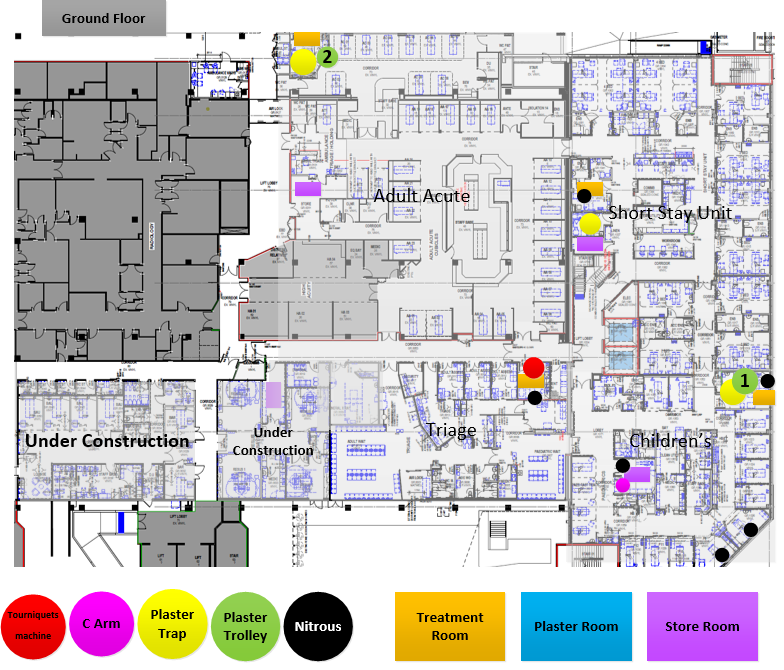This document is a summarised version of Emergency Department DP-GC6-Emergency Department Adult Procedural Sedation and Emergency Department DP-GC6-Sunshine Hospital Emergency Department Paediatric Procedural Sedation. The summary has been created to be Emergency Department specific, and has been endorsed by the ED Leadership Team. Staff should review the PPG if they require further information.
Overview
This QRG provides an overview of the Plastering Process in SHED, including the location of plastering spaces and equipment. This QRG is aimed to represent the plastering processes for Stage 2, March 2021 ED expansion.
The general principle is that staff should do plastering at the patient’s bedside by taking a plaster trolley and a floor protector sheet (eg. plain linen bed sheet) and then cleaning up afterwards including emptying the plaster bucket down one of the sinks outlined below which have a plaster trap. Plaster MUST NOT be emptied down a normal sink without a plaster trap.
The procedure rooms should only be used when the patient needs to be in one for other reasons such as need to reduce the fracture, provide nitrous oxide or conscious sedation.
The Bier’s block machine will be stored in the Procedure Room at Triage.
The image intensifier will be stored in the children’s store room.
- Note that there is no nitrous outlet in the Adult Acute Assessment Treatment Room in old EOU
- When possible, the plaster saw should not be used in procedure rooms in order to avoid plaster dust contamination. Use of plaster saw should be at bedside with patients in single rooms such as the triage assessment rooms or a single bed cubicle.
Applicability
This QRG is applicable to all SHED clinical staff.
Responsibility
The Nurse Unit Managers and Medical Directors are responsible for ensuring that all relevant staff are appropriately aware of the Plastering Process in SHED.
Process Details
- Plaster Trap locations:
- Children’s Treatment Room
- Adult Acute Assessment Treatment Room in old EOU
- Short Stay Unit Dirty Utility Room
- Note that there is NO plaster trap in the Procedure room at Triage nor the negative pressure rooms.
- Plaster store room locations:
- Short Stay Unit store room – plaster only
- Children’s store room – plaster and Dynacast
- Children’s treatment room – Dynacast dispenser only
- Adult Acute Assessment Treatment Room in old EOU – Dynacast dispenser only
- Procedure room at triage – Dynacast dispenser only
- Plaster saw and plaster removal tools locations:
- There will be a plaster saw for each POD (SSU, Children’s and Adult Acute)
Figure 1: Footprint mark up for ground floor

Plaster Trolley and Supplies
- Small amount of stock (plaster, crepe bandages, tape, underpadding) to be available on each trolley (2)
- Trolley locations can be seen in figure 1 above:
- Children’s treatment room
- Adult Acute Assessment Treatment Room in old EOU
- Further Paediatric and adult stock including Dynacast will available in the plaster store rooms.
Plaster storage supplies will include:
- Paper style slings
- Plaster
- Crepe bandages
- Stockinette
- Dynacast fibreglass (Paediatrics)
Stored equipment will include:
- Crutches (with blank hire forms)
- Zimmer splints
- CAM boots
- Broad arm slings
- Aluminium finger splints
- Mallet splints
The above equipment items can only be given to patients once the hire form has been completed.
Supporting Documents
| Title: |
Plastering Process SHED |
| Version: |
1.0 |
| Date Published: |
February, 2021 |
| Date of scheduled review: |
01/05/2021 |
| Author: |
Approver: |
| Gary Ayton |
SHED Leadership Team |

